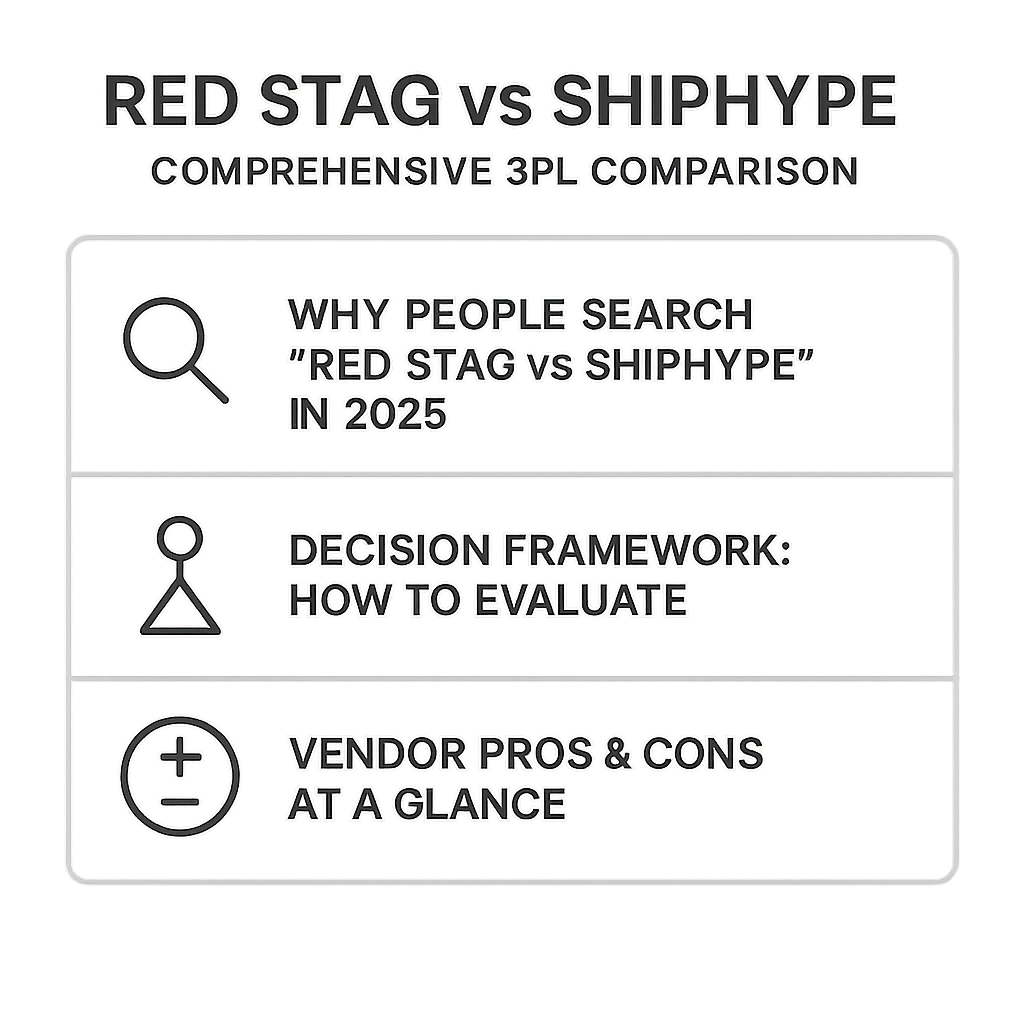
Red Stag vs ShipHype
Choosing between Red Stag and ShipHype can feel daunting, especially with the stakes of eCommerce logistics in 2025. This guide will help you navigate the decision by comparing key aspects such as pricing, features, and onboarding processes.
Why People Search ‘Red Stag vs ShipHype’ in 2025
In 2025, the logistics landscape is shaped by AI-driven forecasting and sustainability demands. Companies are increasingly seeking 3PLs that can offer not just cost efficiency but also adaptability to these trends. Red Stag and ShipHype are often compared due to their robust service offerings and reputation for reliability. As eCommerce continues to grow, the need for efficient and scalable logistics solutions becomes paramount.
- Consider how each 3PL aligns with your sustainability goals.
- Evaluate the technological capabilities of each provider, especially in AI forecasting.
- Assess the scalability of services to match your business growth.
Decision Framework: How to Evaluate
When evaluating Red Stag vs ShipHype, logistics managers should consider several key criteria. First, assess the geographic coverage each provider offers. This is crucial if your business plans to expand internationally. Second, look at the technology stack and integration capabilities. Seamless integration with your existing systems can save time and reduce errors.
Additionally, consider the level of customer support and the flexibility of service offerings. A provider that can tailor its services to your specific needs will likely offer better long-term value.
- Check for compatibility with your current eCommerce platforms.
- Ensure the provider offers robust customer support, ideally 24/7.
- Look for flexible service packages that can adapt as your needs change.
Vendor Pros & Cons at a Glance
- Red Stag:
- Pros: High accuracy in order fulfillment, strong security measures.
- Cons: Higher cost, limited international presence.
- ShipHype:
- Pros: Competitive pricing, extensive international network.
- Cons: Variable customer service quality, less specialized in niche markets.
Red Stag is ideal for businesses prioritizing accuracy and security, albeit at a higher cost. ShipHype offers broader international reach and competitive pricing, though it may require more diligence in customer service interactions.
Pricing & Total Landed Cost: What Really Moves the Number
Pricing models for Red Stag and ShipHype differ significantly, impacting your total landed cost. Red Stag typically charges a premium for its high-accuracy services, which can be justified by reduced error rates and returns. ShipHype, on the other hand, offers more competitive pricing, which can be advantageous for businesses with high-volume, low-margin products.
- Red Stag’s cost structure includes higher fees for enhanced security and accuracy.
- ShipHype offers volume discounts, making it attractive for large-scale operations.
- Consider the impact of error rates on your overall logistics costs.
Feature-by-Feature Comparison
- Order Accuracy:
- Red Stag: 99.9% accuracy rate.
- ShipHype: 98% accuracy rate.
- Geographic Coverage:
- Red Stag: Strong in North America.
- ShipHype: Global reach with multiple international warehouses.
- Technology Integration:
- Red Stag: Advanced API for seamless integration.
- ShipHype: Basic integration options, with room for customization.
Red Stag excels in order accuracy and technology integration, making it a strong choice for businesses where precision is paramount. ShipHype’s global reach and flexible pricing make it suitable for companies looking to expand internationally.
Scenario Playbook: Who Should Choose What?
- High-Value Products: Red Stag is ideal due to its exceptional accuracy and security.
- Global Expansion: ShipHype’s international network offers a strategic advantage.
- Cost-Sensitive Operations: ShipHype’s competitive pricing can maximize margins.
Onboarding & Risk Mitigation
Both Red Stag and ShipHype offer structured onboarding processes, but they differ in approach. Red Stag provides a detailed onboarding plan with dedicated account managers, ensuring a smooth transition. ShipHype offers a more flexible onboarding process, which can be beneficial for businesses that require quick setup.
Mitigating risks during onboarding involves clear communication and setting realistic expectations. Ensure that both parties understand the KPIs and service levels agreed upon.
Expert Take
In my experience, choosing between Red Stag and ShipHype often comes down to the specific needs of the business. One client, a high-end electronics retailer, chose Red Stag for its precision and security, which drastically reduced their return rates. Conversely, a fashion brand opted for ShipHype to leverage its international reach and cost-effective pricing. The key is aligning your choice with your strategic priorities.
Further Reading
FAQs
How do pricing models differ for ‘Red Stag vs ShipHype’?
Red Stag generally charges a premium for high accuracy, whereas ShipHype offers competitive pricing with volume discounts.
What support model should I expect?
Red Stag provides dedicated account managers, while ShipHype offers flexible support options.
Which industries benefit most?
Red Stag is ideal for high-value products, while ShipHype suits cost-sensitive and global operations.
How long does onboarding take?
Red Stag’s structured onboarding can take several weeks, while ShipHype offers quicker, more flexible options.
Can multi-node reduce both cost and transit time?
Yes, using multi-node logistics can optimize both cost and transit time, especially with ShipHype’s global network.
Next Steps
Ready to make a decision? Compare quotes or schedule a consultation to find the best fit for your logistics needs.

Leave a Reply